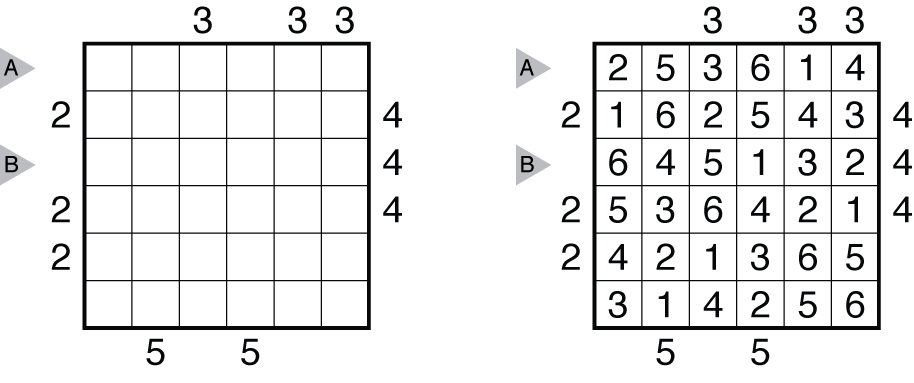Skyscrapers Rules and Info

Rules: Insert a number from 1 to N into each cell in the N by N grid so that no number repeats in any row or column. Also, each number in the grid represents the height of a building and the clues on the outside of the grid indicate how many buildings can be “seen” when looking from that direction. Taller buildings block the view of smaller buildings. For example, if a row contained the numbers 15342, then two buildings are seen from the left – 1 and 5 – and three buildings from the right – 2, 4, and 5 – with the other buildings blocked by taller buildings in front of them.
Answer String: Enter the row/column marked “A”, followed by a comma, followed by the row/column marked “B”. Rows are entered left to right and columns from top to bottom. This example has the key “253614,645132”.
(Brief) History of Skyscrapers: Descended from other Latin Square puzzle types, Skyscrapers is a Japanese creation. It received its first broad exposure at the 1st World Puzzle Championship in NYC in 1992 when publisher Sekai Bunka-sha presented a 20 page English edition of their Puzzler magazine to the competitors. (If you know more about the original author/publication of this style, please tell us).
History of this example: This puzzle was written by Thomas Snyder for the 2010 Turkish Puzzle Championship.
Sources for Skyscrapers Puzzles: Follow this link for classic Skyscrapers puzzles on this website and this link for variations on Skyscrapers puzzles. If you are new to this puzzle type, here are our easiest Skyscrapers Puzzles to get started on. More Skyscrapers puzzles can be found in The Art of Puzzles, in our beginner-friendly collection Intro to GMPuzzles by Serkan Yürekli, and in the e-book Skyscrapers by Ashish Kumar.
Design rules for contributors: A Grandmaster Skyscrapers will have a unique solution that can be reached by logic alone. Typically, only outside clues are permitted but on rare occasions given numbers inside the grid are allowed if the theme/solution is interesting enough. Sizes from 5 by 5 to 9 by 9 are recommended.
